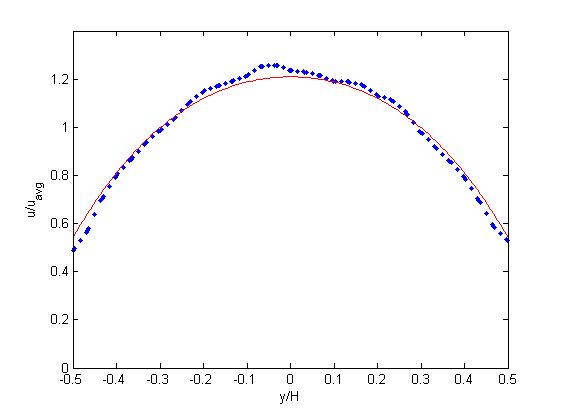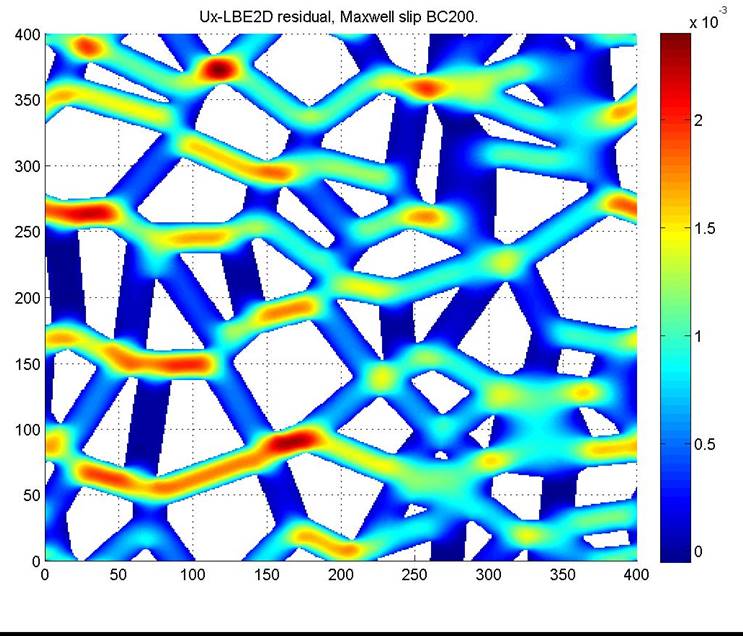Reports: DNI852520-DNI8: Direct Simulation of Slip and Transitional Flows of Gas in Nanoporous Media using Lattice Boltzmann and DSMC
Xiaolong Yin, PhD, Colorado School of Mines
In this year, we studied slip flow in porous media geometry
models made up by overlapped spheres and randomly connected 2D channel
networks, characterized the effect of finite Reynolds number on the drag
coefficient of periodic arrays of spheres with slip boundaries, and compared
DSMC simulations with lattice Boltzmann simulations in the slip flow regime in
a 2D channel.
For geometry of overlapped spheres, we noted that the scheme
of computing the surface normal has an influence over the stability of the
numerical simulation, and the scheme that uses the local configuration of fluid
and solid nodes to compute the surface normal provides
a solution. In these geometries, as hypothesized, the contrast between pore
body and pore throats, which increases with decreasing porosity, intensifies
the degree of slip. Dimensionless permeability, defined as kapp
/ k where kapp is the apparent
permeability and k is the Darcy permeability, increases with increasing Knudsen
number and increases with decreasing porosity. Nonlinearity is observed in the
dependence of kapp / k on the Knudsen
number and it is attributed to the curvature of the solid surface. Indeed, in
slip flows through 2D channel networks, very little nonlinear dependence of kapp / k on the Knudsen number was observed.
We extended the previously reported study of drag /
permeability of periodic arrays of spheres by increasing the Reynolds number of
the flow from zero (Stokes flow) to 5-8. Slip is usually associated with low
Reynolds number; however, in certain processes such as combustion and dust
transport in rarefied conditions, slip can be associated with finite Reynolds
number, yet the flow still has a low Mach number and can be treated as nearly
incompressible. We characterized the drag on periodic arrays of spheres with
low Knudsen number and finite Reynolds number, as the first attempt to
understand the effect of hydrodynamic interaction on drag under rarefied
conditions, and established correlations.
To compare with lattice Boltzmann simulations with slip, we
conducted preliminary DSMC simulations of rarefied flow through a 2D channel.
Agreement between DSMC and lattice Boltzmann simulation agreed until Knudsen
number reached about 0.2. We will continue to compare DSMC and lattice
Boltzmann simulations in more complex geometries, to establish the respective
ranges of Knudsen numbers for the two direct simulation methods.
This grant has been used to fund a PhD student, co-fund an
undergraduate student, and co-fund a postdoctoral researcher’s position, which
was held by the PhD student for six months after his graduation.
Figure 1 – Comparison between DSMC simulation (dots) and
lattice Boltzmann simulation with surface slip (line) at Kn = 0.171. The tangential momentum accommodation
equals 1.0.
Figure 2 – Distribution of x-velocity in a 2D porous medium
model with random channel network. Flow direction is from left to right. The
porosity of the model is 49%, Kn
= 0.05 and the tangential momentum accommodation coefficient is 0.8. All units
are in lattice units (unit grid spacing and time step).













